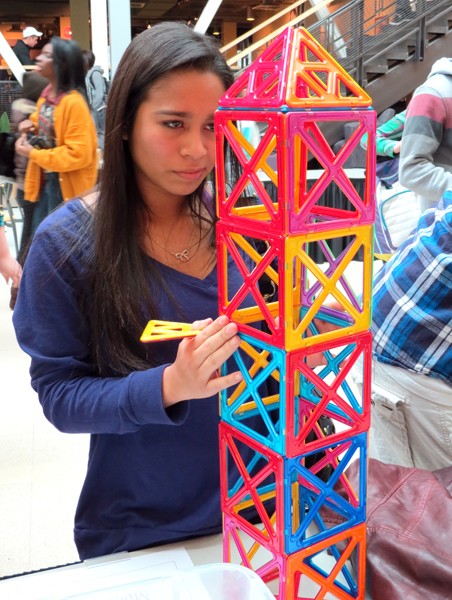Women and Minorities in STEM
 Area high school students on February 13 got some hands-on experience with science at Weber State University.
Area high school students on February 13 got some hands-on experience with science at Weber State University.
The students used ordinary objects and toys to sample scientific principles and learn about static electricity, basic structural engineering, near-perpetual motion, and how looking through clear lenses can alter the view. The students were there as part of a GEAR UP activity, aimed at motivating low-income students to graduate from high school and prepare for college.
Another goal of the gathering was to promote study in STEM fields, which are science, technology, engineering and math. Sharing insights on the topic was Mona Humphries Bailey, a Seattle science educator and administrator, and a former national president of Delta Sigma Theta, a sorority that supports black women in achieving academic excellence.
“U.S. students rank 25th in math scores,” Bailey said. “We rank 12th as a country in science scores. There are too few students prepared for higher education. Only one-third of the students universities in the U.S. are producing have degrees in STEM fields, and two-thirds of the jobs that will be available to students are in the STEM fields.”
Bailey told her audience that STEM fields are where most of the jobs of the future will be found, and at present, they’re also the fields where minority workers and women are rarely found. There’s also a shortage of American women and minorities teaching STEM topics at universities, she said.
“We must try to change this picture, and guess what?” Bailey asked her listeners. “I am looking at the beautiful people who can change this.”

Bailey said STEM jobs tend to pay nearly twice the salary of jobs in non-STEM fields. Noting a study she read recently, Bailey said the average annual salary for a science, technology, engineering or math job is $77,880. The average career outside the STEM area pays about $44,000, Bailey said. Her grandson, who is near completing a college degree in chemical engineering, was told at a recent interview he could earn about $80,000 as starting pay, Bailey said.
Her own starting pay as a teacher, decades back, was less than $10,000, Bailey said.
“That was a different time, of course,” she said. “It almost seems like a different world.”
Bailey said she believes women and minorities lag behind in STEM fields because traditionally both groups may have been viewed wrongly as not smart enough to master such challenging areas of study. In addition, financial challenges keep many low-income students from attending or completing college, she said.
An investment in education pays off, Bailey said. Unemployment stands at about 5.3 percent for people in STEM fields and about 10 percent for those not in STEM fields, she said.
Bailey said there is nothing wrong with earning degrees in non-STEM areas, “if that’s where your heart takes you.” But for those who enjoy science, technology, engineering or math, a degree is the key to a bright future.
“You hold the future of this nation in your hands,” Bailey said. “Most jobs in the future will not be hiring high school graduates” without further education, she said.
Originally written by Nancy Van Valkenburg for the Ogden Standard Examiner
